Quote:
Another thing really annoying.. The stedimeter for checking range.. Its so off its stupid.. I cheat by checking the map, and every ship is always way off..
When I check the range in the map and if its say 1500 yards, to get that using the stedimeter, your not even close to matching the masts..
|
If your using OTC with TMO 2.5, all ships in the Recognition Manual have a red mark indicating where you set the stadimeter waterline. Many are using the funnels, but most use the mast top.
Here's the Nagara Maru, use the funnel top (it's marked in red):

Here's a Bogue CV using the top of the ships superstructure as the measuring point:

To properly make a good stadimeter reading.....ID the target ship, then mouse click the "Checkmark" at the top/right of the RM page to "send" the
Height: measurement to the Position Keeper/TDC. You know the proper ship Height: is in the computer when you read its name at the top of the PK. Take the Stadimeter reading with the placement of the waterline directly on (in the case of the Bogue target) the top of the superstructure. "Send" the reading to the PK/TDC.
It's important to note that the farther away you are from the target, the greater the error in range reading will be
IF you set the waterline image just a pixel width off the mark!! You need to be really careful in where you make the mark......so much so, that if you twitch the mouse when you press the left key just a bit, you'll throw off the range estimate! How much depends on how far away you are from the target. I've tested this many times (after all, that's why with OTC or SCAF, both have the correct "Height:" marked in the RM). I've found if the target is far away (say 2500+ yrds), the error in getting a range is much greater than say a target at only 1500 yrds distance. Just one pixel width difference could throw off the range estimate by 100's of yards. How wide is a pixel?......the telemeter divisions on the OTC scope lens are one pixel width wide.
You need to realize the farther away the target, the greater the error if you miss the exact spot you wish to measure. With two moving targets, rough seas, and a twitchy finger, you're more likely to get an error than an accurate reading. That's why you need to use
all your resources in gleaning information.
+Use the sonar if you dare.
+Use the telemeter divisions to measure a ships height with the aid of the Range Omnimeter.
+Use radar if it's available.
+Use the navigation map to keep a plot of the targets position (with or without the contacts being updated).
Really, it's only after putting several pieces of the equation together, and doing it several times each, will you get a good firing solution. After practice, you can shoot from the hip to get that passenger ship that surprised you.
